Bridges
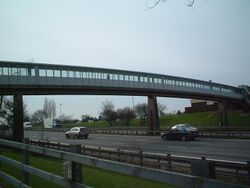
One of the most surprising aspects of service stations which we receive a lot of queries about is bridges. Perhaps this is because, while the interior of every service station has started to become indistinguishable from any large food court, the presence of a bridge over the motorway remains unique to the motorway service area. The idea of your building being divided into two by a motorway is a unique architectural challenge, and offers visitors an unusual vantage point.
The structure of the bridge itself is owned by the highway authority - normally Highways England - while any building attached to it is maintained by the service station operator.
- Services with an internal bridge
- Services with an external footbridge
- Dual-site services (the type where you'd expect to find a bridge, but not all of them have one)
Benefits of Bridges
Bridges are mainly provided for the benefit of the operator. They allow staff and stock to be easily moved from one side to the other.
In the early days, it was common to close the facilities on one side and ask customers to cross the bridge to the other. When the motorways were quieter, the government encouraged service stations to save money by only building on one side. These days we tend to find that the basic facilities are provided on both sides, but a different line-up of brand names may be provided on each side and both advertised all around.
In 2016, Fleet southbound was destroyed by a fire. Access to the bridge wasn't damaged so Fleet was able to re-open almost immediately by directing customers to the bridge, which kept things going until a better solution was found.
Problems with Bridges
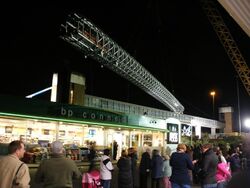
The main problem with bridges is that they are very difficult to build after the motorway has been built. It requires several months of roadworks and at least one overnight closure. The highway authority will expect a considerable bill to be paid by the operator, who will usually conclude that it's not worth it.
Similarly, bridges can be difficult to maintain. Many motorway bridges were built in the early 1960s, and the highway authorities have enough work to do trying to maintain them all without having to cooperate with all the different service station operators too. Even basic maintenance like repainting could have an affect on the traffic below, while emergency repairs can be catastrophic. In 2010, Medway services had a broken window on its bridge, which caused the M2 to be completely closed.
Bridges quickly fell out of favour with customers too. They are psychological barriers: while most people would happily stroll around a few shops, they hate walking up stairs. If the customer has to walk up the stairs, and especially if they have to make a long walk along an empty and noisy bridge, by the time they get to the other end they have usually lost all interest in whatever it was they came for. As a result, facilities positioned on the bridges noticed a drop in trade. In addition, awareness of accessibility issues made working with a bridge more expensive, and that cost couldn't be justified.
Sometimes, the layout of the land means it's simply not possible to have two buildings opposite each other. Similarly, by the late 1960s, the preferred design was to position the main buildings far away from the motorway. This makes working with bridges difficult, as you have to design a safe route to get pedestrians through the car park and across the main access road, even if you don't think anybody will bother with it.
The other point to consider is that as far as the operator is concerned, the best layout is to build offline. This offers them all the benefits of a bridge, but with none of the drawbacks.
History: Why Bridges Were Provided
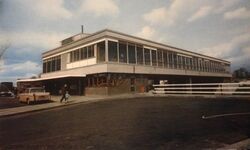
See also: How To Design A Service Station
While we've outlined the advantages and disadvantages above, many of those were only discovered with hindsight.
When the first section of the M1 was built, 71 bridges were provided. The cost of including another four for the service areas was relatively tiny, and much less than going back later and fitting the bridges when the service stations were ready. This was decided with very little debate.
The first services were all experiments. Watford Gap didn't make much use of its bridge, but the bridge did allow the southbound side to serve customers three weeks earlier. Newport Pagnell decorated their bridge and made it an integral part of the design, even though it didn't see much use. At Toddington, the bridge was a nuisance: it was built before the service area had been designed, and it turned out to seriously limit the design possibilities.
Building Above The Motorway
Within the following few years, bridges became a bit of a fashion accessory. They helped architects to create unique and striking designs while the public had never had an opportunity to stand and admire the fast-moving traffic before and seemed to relish it.
This quickly led to the unusual, European-inspired design of having the entire building straddle the motorway. This looked impressive from the motorway and offered customers the novel experience of dining above the traffic. It's true that there was a fire at Keele in 1984 which caused problems for the M6 below, but that has nothing to do with why this design stopped being built. In truth, it was only a fashion trend, and once a few had been built people lost interest. One minister commented that bridge-restaurants were distracting for drivers below, which may have encouraged developers to find a new design.
The five services with facilities above the motorway are: Charnock Richard, Knutsford, Keele, Leicester Forest East and Medway (Farthing Corner). They were all built between 1963 and 1966, and after that the priority became building things cheaply. These five cover some of the UK's oldest, and therefore busiest, motorways, so are well-remembered.
Cover It Up Rule

In the following few years, operators would normally give their bridges a shelter, for customer and staff convenience. Despite the appearance of a roof and walls, this shelter was much less robust than a proper building, causing the bridge to appear cold and damp. Wind caused by the exposed location and the effect of passing traffic could even make a sheltered bridge a little unnerving. Footbridges would continue to be provided by the Ministry, but increasingly they wouldn't be connected to the main building.
As the motorway network began to expand into quieter regions, lack of traffic became a major problem for new service areas. The Ministry established a rule where a service area could provide virtually no facilities on one side, on condition that a short, covered walkway was provided. Whole studies were done into which side of the motorway should get the facilities, and formulas produced (although they were probably never used).
Lancaster and Washington were early examples of this. Southwaite took it much further. Now that Southwaite has been expanded to provide facilities on both sides, the covered footbridge between the two car parks seems a bit odd.
Going Without A Bridge
Between the opening of the first services in 1960 and the change to the planning process in 1992, the only services to open without a bridge were:
- Frankley (opened in 1966) - in order to encourage a more bespoke design in what was a difficult area. The operator were allowed to pay for one, but didn't.
- Heston (opened in 1967) - the service area was delayed and the M4 was already open. Also issues with its layout
- Woolley Edge (opened in 1972) - unsuitable ground conditions and would have needed a very high bridge
- Sedgemoor (opened in 1975?) - was originally built with the absolute minimum expenditure possible
- Warwick (opened in 1994 but under the old planning system) - was built after the motorway
We are excluding from this list services which were only serving one side of the motorway (Tebay was initially built like this), or services which were positioned at a junction. The latter became increasingly popular during the 1980s, and made up the vast majority of the Department of Transport's new service area proposals.
In the 1960s, the roads, car parks, bridges and landscaping at motorway services were built using the same contract that was built to use the motorway itself. This allowed motorway services to open on the same day as the motorway. By the 1970s, the two contracts had been separated, causing the service areas to open after the motorway. If the exact position of a service area was known while the motorway was being designed, the bridge would be built with the motorway. This happened at Sandbach and Fleet, where for a few years a bridge connected two fields. More often than not, the position of the service area would not be known, so a bridge would not be built.
In 1992, the government stopped having any involvement in new service area proposals. This means that there is little chance of a new motorway service area bridge ever being built (and none have been built since then).
Trading from service area bridges was banned for new-builds in the 2008 regulations. This rule was lifted in 2013, but it would still be difficult to build a new restaurant above a busy motorway.
Unusually, Transport Scotland built a new bridge at Heart of Scotland in 2008, to encourage its use as a park-and-ride facility.
Removing Bridges
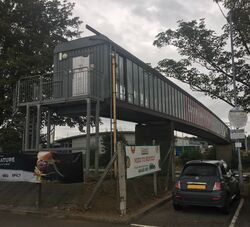
Now that all services provide the main facilities on both sides of the bridge, the bridges are generally redundant. Most continue to be used as it's easier to keep things going, but some have been closed:
- Strensham's was demolished in 1991, as one half of the service area was moved. It was also too narrow for the widened M5
- Hilton Park had its bridge closed from about 2000 until 2005, due to maintenance issues
- Northampton's was locked out of use in 2002 as it didn't fit the maintenance plan
- Burtonwood's subway was closed in 2008 - a tenuous example because the whole building closed
- Michaelwood's was closed in 2018 for safety reasons, and eventually removed in 2020. There is a vague plan to replace it
Some other bridges which once plugged directly into the amenity building at each end no longer do this, to suit refurbishment projects. This happened at Birch and Woodall.
In the 1990s there were plans to widen the M6, and there was talk about some of its services needing to be demolished. Since then, many motorways (including the M6) have been widened, but it has managed to squeeze past the service areas and their bridges. This can only be done once, so if the M1 is ever widened again (as is occasionally proposed), Leicester Forest East would need to be demolished.
A-roads
As A-road services are planned largely by the private sector, it's very rare that a pedestrian footbridge will be included by the plan. Sutton Scotney (built 1986, after the road) is a good example of this not happening.
The more remarkable examples are where bridges have been provided. Barnsdale Bar and Easington are two, but both have since been removed.
Alternatives To A Bridge
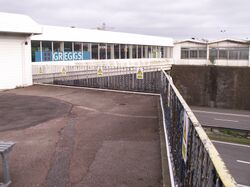
Sometimes a motorway will be built on an embankment, slightly above the height of the ground. To keep costs down, the service area will be built at ground level, and a subway will be built instead of a bridge. This was suggested in a few places, but only Rownhams and Burtonwood ever got one. Plenty more were built but never used, like at Hatfield.
Many service areas are connected by a road bridge positioned outside their boundary. These aren't supposed to be for public use but sometimes get used a lot anyway. At Gloucester, a public footpath leading to that bridge means that there technically is a pedestrian route available, albeit a long one.
The most interesting design is Medway. Here, the motorway is in a cutting well below the height of the ground, and the service area wasn't lowered to match it. As a result, the building is positioned much higher than the motorway, and is able to cross it with a simple, elegant stride. The fact that low traffic levels mean the building hasn't really been expanded makes it even more pleasing: it doesn't have any clunky extensions which sprawl out on one side, and instead it really does look like one building which happens to have a motorway running beneath it.
A step-free layout like Medway could have been provided at many other service areas, by being a little more flexible with the landscaping. It makes no difference to the cars if the car park is positioned at the top of a hill, after all. Unfortunately, as explained above, bridges and landscaping were paid for by the government, in an era where there was little understanding of accessibility or customer behaviour, so they preferred the cheapest and easiest layout.
Medway is the only example in the UK of a design which is built above the motorway, but without any interior or major exterior flights of stairs being involved. There are all sorts of unusual examples across Europe, including one striking example near Nivelles in Belgium, where the main building acts as both a bridge above the motorway and a canopy for the two petrol stations.
Consequences of a Bridge
Until recently, bridges had legal consequences.
Government regulations limited the size of shopping and gaming areas at service stations. In the 1990s, there was confusion about whether these restrictions were applied to the whole complex, to each side individually, or whether the bridge made a difference. The Highways Agency took the position that it applied to the whole complex, while many councils disagreed. In 2008, the rules were clarified, and the Highways Agency stated that if the size limits were exceeded, then any bridge or underpass must be taken out of public use and removed "at an appropriate time".
That wording is curious, as the Highways Agency appeared to be encouraging the removal of bridges, despite knowing such work would be a major inconvenience for them.
MSO Wet Weather Rule
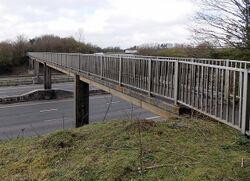
For some customers, walking up the stairs and over the bridge is no big deal, while for others it's not worth the effort. What really matters is how long the walk is, how much time you have and how much you want to get to the other facilities. This makes it difficult for a website like Motorway Services Online to provide a simple system that tells people whether the facility they are looking for is available or not.
To keep things simple, we use the "wet weather rule". Say that you are heading northbound and the facility you want is on the southbound side. If the walk from one side to the other is entirely covered, we record the facility as available, with no further detail needed. If the bridge isn't covered, the bridge takes you into the car park or the facility is outside the main building, we would record it as "southbound only". At the top of the page it would explain that a footbridge is available.
The exceptions to this are Changing Places, which we would record as "southbound only" if any bridge was involved at all, and any hotel, which we would record as "southbound only" if there was no easy way to drive there.